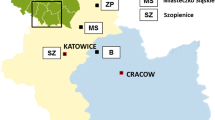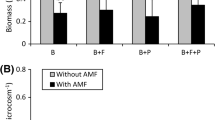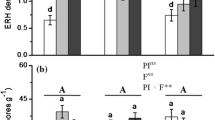Abstract
Goat willow (Salix caprea L.) was selected in a previous vegetation screening study as a potential candidate for the later-stage phytostabilisation efforts at a heavily metal polluted site in Slovenia. The aims of this study were to identify the fungi colonising roots of S. caprea along the gradient of vegetation succession and to estimate their colonisation levels in relation to metal pollution in order to reveal its mycorrhizal status at the site. Additionally the metal accumulation capacity of S. caprea and photosynthetic pigments were analysed as indications of its fitness at four differentially polluted plots. Despite high concentrations of leaf accumulated Cd, no significant differences in photosynthetic pigment concentrations were observed. The roots were colonised by arbuscular mycorrhizal (AM) fungi, ectomycorrhizal (EM) fungi, and dark septate endophytes (DSE), with EM as the dominant type on all the plots. Molecular characterisation showed poor correlation of the root EM community with the above-ground sporocarp diversity. Members of Sordariaceae were the most frequent colonisers with an average colonisation of 21% of all root tips, followed by Thelephoraceae with 10%. DSE colonisation increased with increasing Pb concentrations and decreasing organic matter (OM).



Similar content being viewed by others
References
Adriaensen K, Vralstad T, Noben JP, Vangronsveld J, Colpaert JV (2005) Copper-adapted Suillus luteus, a symbiotic solution for pines colonizing Cu mine spoils. Appl Environ Microbiol 71:7279–7284
Adriaensen K, Vangronsveld J, Colpaert JV (2006) Zinc-tolerant Suillus bovinus improves growth of Zn-exposed Pinus sylvestris seedlings. Mycorrhiza 16:553–558
Agerer R (1996–2006) Colour atlas of ectomycorrhizae Germany, Einhorn Verlag, Schwaebisch Gmuend
Altschul SF, Madden TL, Schäffer AA, Zhang J, Zhang Z, Lipman DJ (1997) Gapped BLAST and PSI-BLAST: a new generation of protein database search programs. Nucleic Acids Res 25:3389–3402
Bellion M, Courbot M, Jacob C, Blaudez D, Chalot M (2006) Extracellular and cellular mechanisms sustaining metal tolerance in ectomycorrhizal fungi. FEMS Microbiol Lett 254:173–181
Cazares E, Trappe JM, Jumpponen A (2005) Mycorrhiza-plant colonization patterns on a subalpine glacier forefront as a model system of primary succession. Mycorrhiza 15:405–416
Colpaert JV, Muller LAH, Lambaerts M, Adriaensen K, Vangronsveld J (2004) Evolutionary adaptation to Zn toxicity in populations of Suilloid fungi. New Phytol 162:549–559
Dahmani-Muller H, van Oort F, Gelie B, Balabane M (2000) Strategies of heavy metal uptake by three plant species growing near a metal smelter. Environ Pol 109:231–238
Dickinson NM (2000) Strategies for sustainable woodland on contaminated soils. Chemosphere 41:259–263
Fernando AA, Currah RS (1996) A comparative study of the effects of the root endophytes Leptodontiudium orchidicola and Phialocephala fortinii (Fungi Imperfecti) on the growth of some subalpine plants in culture. Can J Bot 74:1071–1078
Gadd GM (1993) Tansley review No. 47. Interaction of fungi with toxic metals. New Phytol 124:25–60
Gardes M, Bruns TD (1993) ITS primers with enhanced specificity of basidiomycetes: application to the identification of mycorrhizae and rusts. Molec Ecol 2:113–118
Hammer D, Kayser A, Keller C (2003) Phytoextraction of Cd and Zn with Salix viminalis in field trials. Soil Use Manage 19:187–192
Hartley J, Cairney JWG, Meharg AA (1997) Do ectomycorrhizal fungi exhibit adaptive tolerance to potentially toxic metals in the environment? Plant Soil 189:303–319
Haselwandter K, Read DJ (1982) The significance of a root-fungus association in two Carex species of high-alpine plant communities. Oecologia 52:352–354
Huang JW, Cunningham SD (1996) Lead phytoextraction: species variation in lead uptake and translocation. New Phytol 134:75–84
Jumpponen A (2001) Dark septate endophytes—are they mycorrhizal? Mycorrhiza 11:207–211
Jumpponen A, Trappe JM, Cázares E (2002) Occurrence of ectomycorrhizal fungi on the forefront of retreating Lyman Glacier (Washington, USA) in relation to time since deglaciation. Mycorrhiza 12:43–49
Kayama M, Choi D, Tobita H, Utsugi H, Kitao M, Maruyama Y, Nomura M, Koike T (2006) Comparison of growth characteristics and tolerance to serpentine soil of three ectomycorrhizal spruce seedlings in northern Japan. Trees Struct Funct 20:430–440
Kõljalg U (1996) On the systematics and phylogeny of Tomentella (Thelephorales, Basidiomycota) and related genera. - In: Abstracts of the First International Conference on Mycorrhizae. Berkeley, University of California, p 72
Kovacs GM, Szigetvari C (2002) Mycorrhizae and other root-associated fungal structures of plants of a sandy grassland on the Great Hungarian Plain. Phyton 42:199–210
Krupa P, Kozdroj J (2007) Ectomycorrhizal fungi and associated bacteria provide protection against heavy metals in inoculated pine (Pinus sylvestris L.) seedlings. Water Air Soil Pollut 182:83–90
Kruskal JB (1964a) Multidimensional scaling by optimizing goodness of fit to a nonmetric hypothesis. Psychometrika 29:1–27
Kruskal JB (1964b) Nonmetric multidimensional scaling: a numerical method. Psychometrika 29:115–129
Krznaric E, Verbruggen N, Wevers JHL, Carleer R, Vangronsveld J, Colpaert JV (2009) Cd-tolerant Suillus luteus: a fungal insurance for pines exposed to Cd. Environ Pol 157:1581–1588
Kumar S, Dudley J, Nei M, Tamura K (2008) MEGA: a biologist-centric software for evolutionary analysis of DNA and protein sequences. Brief Bioinformatics 9:299–306
Landberg T, Greger M (1996) Differences in uptake and tolerance to heavy metals in Salix from unpolluted and polluted areas. Appl Geochem 11:175–180
Larsen MJ (1968) Tomentelloid fungi of North America. Technical Publication 93. State University College of Forestry at Syracuse University, New York
Larsen MJ (1974) A contribution to the taxonomy of the genus Tomentella. Mycol Mem 4:1–145
Leyval C, Turnau K, Haselwandter K (1997) Effect of heavy metal pollution on mycorrhizal colonization and function: physiological, ecological and applied aspects. Mycorrhiza 7:139–153
Lichtenthaler HK (1987) Chlorophylls and carotenoids: pigments of photosynthetic biomembranes. Methods Enzymol 148:350–382
Markkola AM, Ahonen JU, Roitto M, Strommer R, Hyvarinen M (2002) Shift in ectomycorrhizal community composition in Scots pine (Pinus sylvestris L.) seedling roots as a response to nickel deposition and removal of lichen cover. Environ Pollut 120:797–803
Marschner H, Dell B (1994) Nutrient uptake in mycorrhizal symbiosis. Plant Soil 159:89–102
Mühlmann O, Peintner U (2008) Mycobionts of Salix herbacea on a glacier forefront in the Austrian Alps. Mycorrhiza 18:171–180
Mullen RB, Schmidt SK, Jaeger CH (1998) Nitrogen uptake during snow melt by the snow buttercup, Ranunculus adoneus. Arctic Alpine Res 30:121–125
Nelson DW, Sommers LE (1982) Total carbon, organic carbon, and organic matter. In: Page AL, Miller RH, Keeney DR (eds) Methods of soil Analysis. Part 2. Agron Monogr 9. ASA and SSSA, Madison, pp 539–580
Obase K, Tamai Y, Yajima T, Miyamoto T (2007) Mycorrhizal associations in woody plant species at the Mt. Usu vocano, Japan. Mycorrhiza 17:209–241
Phillips JM, Hayman DS (1970) Improved procedures for clearing roots and staining parasitic and vesicular–arbuscular mycorrhizal fungi for rapid assessment of infection. Trans Br Mycol Soc 55:158–161
Pinto E (2003) Heavy metal-induced oxidative stress in algae. J Phycol 39:1008–1018
Pulford ID, Watson C (2003) Phytoremediation of heavy metal-contaminated land by trees—a review. Environ Int 29:529–540
Punshon T, Dickinson NM (1997) Acclimation of Salix to metal stress. New Phytol 137:303–314
Read DJ, Perez-Moreno J (2003) Mycorrhizas and nutrient cycling in ecosystems—a journey towards relevance? New Phytol 157:475–492
Reeves RD, Baker AJM (2000) Metal—accumulating plants. In: Raskin I, Ensley BD (eds) Phytoremediation of toxic metals: using plants to clean up the environment. Willey, New York, pp 193–229
Regvar M, Vogel-Mikuš K, Kugonič N, Turk B, Batič F (2006) Vegetational and mycorrhizal successions at a metal polluted site-indications for the direction of photostabilisation? Environ Pollut 144:976–984
Ruotsalainen AL (2003) Mycorrhizal colonization and plant performance in arcto-alpine conditions. Ph.D thesis, Department of Biology, University of Oulu, Oulu, Finland, 43pp
Sander M-L, Ericsson T (1998) Vertical distribution of plant nutrients and heavy metals in Salix viminalis stems and their implications for sampling. Biomass Bioenerg 14:57–66
Smith SE, Read DJ (2008) Mycorrhizal symbiosis, 3rd edn. Academic, London
Smith JE, Johnson KA, Cazares E (1998) Vesicular mycorrhizal colonization of seedlings of Pinaceae and Betulaceae after spore inoculation with Glomus intraradices. Mycorrhiza 7:279–285
Trouvelot A, Kough JL, Gianinazzi-Pearson V (1986) Mesure de taux de mycorhization VA dun systeme radiculaire. In: Gianinazzi-Pearson V, Gianinazzi S (eds) Recherche de methodes destimation ayant une signification fonctionnelle. Mycorrhizae: physiology and genetic. INRA, Paris, pp 216–222
Trowbridge J, Jumpponen A (2004) Fungal colonization of shrub willow roots at the forefront of a receding glacier. Mycorrhiza 14:283–293
Unterbrunner R, Puschenreiter M, Simmer P, Wieshammer G, Tlustoš P, Zupan M, Wenzel WW (2007) Heavy metal accumulation in trees growing on contaminated sites in Central Europe. Environ Pol 148:107–114
Van Assche JA, Clijsters H (1990) Effects of metals on enzyme activity in plants. Plant Cell Environ 13:195–206
van der Heijden EW (2001) Differential benefits of arbuscular mycorrhizal and ectomycorrhizal infection in Salix repens. Mycorrhiza 10:185–193
van der Heijden EW, Vosatka M (1999) Mycorrhizal associations of Salix repens L. communities in succession of dune ecosystems. II. Mycorrhizal dynamics in interactions of ectomycorrhizal and arbuscular mycorrhizal fungi. Can J Bot 77:1833–1841
Vandecasteele B, De Vos B, Tack FMG (2002) Cadmium and zinc uptake by volunteer willow species and elder rooting in polluted dredged sediment disposal sites. Sci Total Environ 299:191–205
Vandecasteele B, Meers E, Vervaeke P, De Vos B, Quataert P, Tack FMG (2005) Growth and trace metal accumulation of two Salix clones on sediment-derived soils with increasing contamination levels. Chemosphere 58:995–1002
Vogel-Mikuš K, Pongrac P, Kump P, Nečemer M, Regvar M (2006) Colonisation of a Zn, Cd and Pb hyperaccumulator Thlaspi praecox Wulfen with indigenous arbuscular mycorrhizal fungal mixture induces changes in heavy metal and nutrient uptake. Environ Pollut 139:362–371
Vralstad T (2004) Are ericoid and ectomycorrhizal fungi part of a common guild? New Phytol 164:7–10
White TJ, Bruns T, Lee S, Taylor J (1990) Amplication and direct sequencing of fungal ribosomal RNA genes for phylogenetics. In: Innis MA, Gelfand DH, Sninsky JJ, White TJ (eds) PCR - protocols and applications—a laboratory manual. Academic, London, pp 315–322
Acknowledgements
The authors wish to thank Dr. Thomas Horton and Ms. Donaraye McKay for their help with molecular work and valuable suggestions. The work was supported by USDA-SLO grant MSZS 3411-99-71-0026 Symbiotic interactions of plants and fungi on polluted sites in Žerjav; MSZS L1-5146-0481-03 Tolerance of organisms in stressed ecosystems and the potential for phytoremediation with sponsors MPI, Mežica Mine and Mobitel d.d.; MSZS PO-0522-0481-03 Ecology and environmental protection; COST 8.38 Managing Arbuscular Mycorrhizal Fungi for Improving Soil Quality and Plant Health in Agriculture.
Author information
Authors and Affiliations
Corresponding author
Additional information
Responsible Editor: Peter Christie.
Rights and permissions
About this article
Cite this article
Regvar, M., Likar, M., Piltaver, A. et al. Fungal community structure under goat willows (Salix caprea L.) growing at metal polluted site: the potential of screening in a model phytostabilisation study. Plant Soil 330, 345–356 (2010). https://doi.org/10.1007/s11104-009-0207-7
Received:
Accepted:
Published:
Issue Date:
DOI: https://doi.org/10.1007/s11104-009-0207-7




